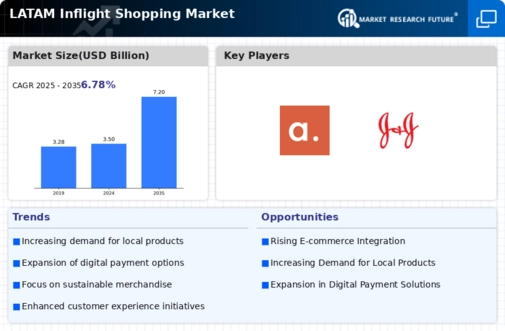Market Share
LATAM Inflight Shopping Market Share Analysis
The LATAM inflight shopping market presents a unique opportunity for airlines and retailers to tap into the purchasing power of travelers while they are in transit. With an increasing number of passengers flying across Latin America, companies operating in this market employ various strategies to position themselves effectively and capture market share. One key approach is product differentiation, where retailers offer a diverse range of products that cater to the preferences and needs of different traveler segments. From luxury goods and electronics to local crafts and souvenirs, providing a wide selection ensures that inflight shoppers have plenty of options to choose from, enhancing their shopping experience and driving sales.
Branding and reputation management are also critical in the LATAM inflight shopping market. Establishing a strong brand presence instills confidence in passengers and encourages them to make purchases onboard. Retailers often collaborate with well-known brands and designers to offer exclusive products or limited edition items, leveraging the allure of prestige and exclusivity to attract customers. Additionally, maintaining a reputation for quality, reliability, and excellent customer service is essential for building trust and loyalty among travelers, ultimately leading to repeat business and increased market share.
Price positioning is another key consideration for companies in the LATAM inflight shopping market. While travelers may be willing to indulge in luxury purchases during their journey, price sensitivity still plays a role in their buying decisions. Retailers must strike a balance between offering competitive prices and maintaining profitability, taking into account factors such as currency fluctuations, duty-free regulations, and local market conditions. Special promotions, discounts, and bundled deals can help retailers attract budget-conscious travelers while maximizing sales and market share.
Effective distribution and channel management are essential components of market share positioning in the LATAM inflight shopping market. Airlines typically partner with onboard duty-free operators or retail management companies to manage inflight sales and logistics. Ensuring seamless integration with airline operations, optimizing inventory management, and leveraging data analytics to understand passenger preferences are critical for maximizing sales opportunities and capturing market share. Furthermore, retailers may explore omni-channel strategies to extend their reach beyond the confines of the aircraft, allowing passengers to pre-order products online or redeem vouchers for in-flight purchases, thereby enhancing convenience and driving incremental sales.
Strategic partnerships and collaborations can also play a significant role in gaining market share in the LATAM inflight shopping market. Retailers may team up with airlines, tourism boards, or destination marketing organizations to promote destination-specific products or experiences, capitalizing on the appeal of travel and exploration. Cross-promotions, co-branded initiatives, and joint marketing campaigns can create synergies that attract passengers' attention and drive sales onboard. Additionally, partnerships with payment providers, loyalty programs, and travel agencies can help retailers reach a broader audience and incentivize purchases, further strengthening their competitive position in the market.
Finally, continuous innovation and adaptation are essential for maintaining market share in the dynamic LATAM inflight shopping market. Retailers must stay attuned to evolving consumer trends, technological advancements, and regulatory changes to anticipate shifting preferences and seize new opportunities. Whether it's introducing innovative product offerings, enhancing the inflight shopping experience with interactive digital platforms, or incorporating sustainable and eco-friendly practices, companies that demonstrate agility and foresight can stay ahead of the competition and secure a significant share of the market.





Leave a Comment